A residential gate access control system is the brain behind the brawn of your property’s entrance. It’s the smart technology that decides who gets in and who stays out, turning a simple physical barrier into your home's first line of defense. Think of it less like a lock and key and more like a personal doorman.
Your Home's First Line of Defense
A residential gate access control system is essentially the central command for your driveway. Its job is to verify identities and grant or deny entry, transforming a passive gate into an active security feature. This move away from manual gates toward smart, automated solutions is really catching on as homeowners look for better ways to manage who comes onto their property.
The numbers back this up. In the United States, the gates market was valued at USD 4.70 billion, with residential gates making up a whopping 43.2% of that. This isn't surprising when you consider how much homeowners are prioritizing security, privacy, and even boosting their property's value. You can dig deeper into these market trends on GrandViewResearch.com.
What Does a Gate Access System Really Do?
At its heart, a gate access system is all about solving real-world problems. It creates a clear, secure perimeter and gives you a simple, organized way to handle visitors, deliveries, and family members coming and going.
But it’s not just about locking people out. It's about letting the right people in without any hassle. A good system gives you a reliable way to:
- Boost Family Safety: It creates a controlled entry point, stopping unauthorized people and vehicles from getting near your home.
- Protect Your Privacy: An automated gate is a great deterrent for nosy neighbors, solicitors, and anyone just passing by, helping keep your home your private sanctuary.
- Manage Visitor Access: You can easily grant temporary codes or scheduled access for guests, contractors, or delivery drivers without ever handing out a main key.
To put it simply, here’s a quick rundown of what these systems do for you:
Core Functions of a Gate Access Control System
| Function | What It Means for You |
|---|---|
| Identity Verification | The system confirms who is at the gate before letting them in. |
| Access Management | You decide who can enter and when, from family to delivery services. |
| Activity Logging | Most systems keep a record of who entered and at what time. |
| Remote Control | You can open or close the gate from anywhere using your phone or a remote. |
A well-designed access control system truly acts as the intelligent perimeter for your home.
It’s the first and most important layer of defense, providing peace of mind by putting you in complete control of who steps onto your property.
In short, these systems are the bedrock of modern property security. They perfectly blend robust protection with everyday convenience, paving the way for a safer, more manageable home. Understanding what they do is the first step in seeing how all the different parts and technologies come together to protect what matters most.
Understanding Your System's Core Components
Every residential gate access control system, no matter how fancy, is built around a few core parts working together. Think of it like a team where each player has a specific job. To really get how your gate keeps your property secure, it helps to know who these players are and what they do.
Let’s break this team down into three simple categories: the muscle, the brain, and the senses. This makes it easy to see how a simple command—like pressing a button on a remote—turns into the smooth, secure opening of your gate.
The Muscle: The Gate Operator
The most obvious and powerful part of your setup is the gate operator, often just called the gate motor. This is the "muscle." Its one and only job is to provide the raw physical force needed to open and close your gate, whether you have a heavy wrought iron gate or a lightweight aluminum one.
Gate operators are built tough to handle serious weight and constant use, doing all the heavy lifting day in and day out. They come in different flavors designed for specific types of gates:
- Slide Gate Operators: These use a chain or a rack-and-pinion system to pull the gate open and push it closed along a track.
- Swing Gate Operators: These usually have an articulating arm or linear actuator that swings the gate open or closed, kind of like a regular door hinge but way stronger.
- Barrier Arm Operators: You've seen these in gated communities. They lift a lightweight arm up and down to manage the flow of cars.
Picking the right operator for your gate’s size and weight is a big deal for its long-term health. An undersized operator will burn itself out, leading to breakdowns and early replacement. For a closer look at the different kinds, you can learn how to select the right gate operators for your needs in our guide.
The Brain: The Control Panel
If the operator is the muscle, then the control panel is without a doubt the "brain" of the whole system. Tucked away in a weatherproof box, this is the central hub that receives signals from your remote or keypad, figures out what to do, and tells the gate operator to get moving.
The control panel is where all the logic lives. When you punch in a code or click your remote, the signal goes here first. It checks that command against its list of approved users and, if everything matches up, it gives the operator the green light to open the gate.
The control panel is the central nervous system of your gate. It manages everything from user permissions and safety sensor inputs to timers that automatically close the gate after a set period.
This is also where a technician will set up most of your system's features, making sure every part communicates and works together safely.
The Senses: Access and Safety Devices
Finally, every system needs "senses" to know when to act and how to do it without causing an accident. These devices are the eyes and ears of your gate access control system, and they fall into two main camps: access devices and safety devices.
Access devices are simply the tools you and your guests use to ask for entry. They’re the main way you interact with your gate. The most common ones include:
- Keypads: Let you in with a simple numeric PIN.
- Remote Controls (Clickers): Send a radio signal to open the gate from the comfort of your car.
- Card Readers: Require a special proximity card or key fob to be tapped or swiped.
- Intercoms: Allow visitors to call you directly so you can grant them access remotely.
On the flip side, safety devices are the non-negotiable parts that protect people, pets, and cars from getting hit by a moving gate. Their job is to spot anything in the gate's path and stop it from closing. These include:
- Photo-Eyes: A pair of sensors that shoot an infrared beam across the gate's opening. If anything breaks that beam, the gate will stop or reverse immediately.
- Edge Sensors: This is a pressure-sensitive strip attached to the edge of the gate. If it bumps into something, it tells the gate to reverse.
- Loop Detectors: Wires buried under your driveway that sense the metal of a vehicle, often used to open the gate automatically for cars leaving the property.
Together, these three groups—the operator, the control panel, and all the sensory devices—create a smart, complete system that gives you both top-notch security and everyday convenience.
Choosing Your Gate Access Technology
Once you have the basics down—the gate operator (the muscle), the control panel (the brain), and the access devices (the senses)—it's time for the fun part: deciding how you'll actually open your gate. This is like choosing the key to your front door. You can stick with a classic, reliable metal key, or you can upgrade to a smart lock you control from your phone.
The method you pick will shape your daily routine and how secure your property feels. It’s a choice that needs to fit your family’s lifestyle, how often you have visitors, and just how much control you want over who comes and goes.
This simple breakdown shows how the 'muscle,' 'brain,' and 'senses' all connect to create a complete system.
Each piece has its job, but the access technology is what you, your family, and your guests will interact with every single day.
Traditional Access Methods
For years, a few tried-and-true technologies have been the standard for residential gates, mainly because they are simple and they just work. They’re straightforward, effective, and perfect for basic access needs.
Here are the most common old-school options:
- Keypads: Punch in a PIN code, and the gate opens. Simple as that. They are incredibly handy for giving out temporary codes to landscapers, house cleaners, or guests. You can easily change the code later without messing with your own.
- Remote Controls (Clickers): These little handheld devices send a radio signal to your gate. They’re a homeowner favorite for a reason—nothing beats the convenience of opening the gate from your car as you pull up to the driveway.
- Proximity Cards or Fobs: Think of the keycard you use at the office. Just tap it on a reader, and you're in. While you don't see them as often at single-family homes, they’re a go-to for apartment complexes and gated communities because they're easy to use and can be deactivated in a snap if one gets lost.
These methods are dependable and get the job done. But they aren’t perfect—remotes get lost, PINs get forgotten—which is why so many people are now looking at more modern, connected solutions.
Modern and Smart Access Technologies
As our homes get smarter, so do our gates. Today’s technology is all about seamless integration, remote control, and beefed-up security, usually powered by the one device we never leave behind: our smartphone.
Smartphone control has completely changed the game. In fact, the global market for gate openers was recently valued at USD 2.66 billion and is projected to hit USD 4.12 billion soon, largely driven by demand for automated gates that sync with smart home ecosystems. You can read more about the growing gate opener market on FortuneBusinessInsights.com.
Here’s what’s popular in the smart tech world:
- Smartphone Apps: An app can turn your phone into the ultimate remote. You can open or close your gate from anywhere, grant access to a delivery driver while you're at work, and even get notifications telling you who opened the gate and when.
- Bluetooth and Wi-Fi Readers: Some systems are so smart they use your phone's Bluetooth signal to sense when you're approaching, automatically opening the gate without you having to do a thing. It’s a truly hands-free experience.
- Intercom Systems (Audio/Video): These let visitors buzz you from the gate. Modern video intercoms are even better—they send a live video feed straight to your phone, so you can see and talk to the person before deciding whether to let them in, even if you’re halfway across town.
The real superpower of smart technology is managing your gate without having to be there. Letting in a contractor while you’re at the office or handling an unexpected delivery has never been easier.
Comparing Your Options
Choosing the right technology is a balancing act between convenience, security, and your family's needs. There’s no single “best” option—it all comes down to what works for you. To get a better feel for different setups, our guide on electric gates for driveways is a great resource.
To make things a bit clearer, we've put together a table comparing the most common access methods.
Comparison of Gate Access Control Methods
This table breaks down the pros and cons of each technology, helping you see which might be the best fit for your property.
| Access Method | Convenience Level | Security Level | Best For |
|---|---|---|---|
| Keypad | Moderate | Good | Granting temporary codes to guests, landscapers, or cleaners. |
| Remote Control | High | Good | Quick, reliable access for primary residents from their vehicles. |
| Smartphone App | Very High | Excellent | Homeowners who want remote control, activity logs, and visitor management. |
| Video Intercom | High | Excellent | Properties with frequent visitors, enhancing security by verifying identity. |
In the end, many homeowners find that a mix of technologies works best. You might rely on a smartphone app for your daily use but keep a keypad installed as a dependable backup for family or service providers. This kind of layered approach ensures your residential gate access control system is not only secure but also perfectly tailored to your life.
The Real Benefits of an Automated Gate System
It's easy to think of an automated gate as just something that opens and closes. But a residential gate access control system is so much more—it’s a smart investment that completely changes how you think about your property’s security, privacy, and day-to-day flow. This technology does more than just create a barrier; it turns your entrance into an intelligent, controlled perimeter.
The biggest and most immediate advantage is a huge leap in security. A physical gate is a powerful visual deterrent, sending a clear message to potential intruders that your property is protected and isn't an easy target. It stops unauthorized cars from pulling into your driveway and keeps casual trespassers or solicitors from ever reaching your front door. That’s a critical layer of protection for your family.
This control over who comes and goes directly enhances your personal privacy. Your home is supposed to be your sanctuary, and an automated gate helps keep it that way. It creates a firm boundary between your private life and the public world, letting you enjoy your property without worrying about uninvited guests or wandering eyes.
Enhancing Daily Convenience and Control
Modern gate systems are built to make your life simpler, not add another chore to your list. The ability to manage access from anywhere is a genuine game-changer for busy families. Think about it: you can let a delivery driver in while you’re at the office or open the gate for a family member who forgot their remote, all from your phone.
The real power of an automated gate system lies in its ability to provide peace of mind. Knowing you have complete control over who enters your property, whether you're at home or away, is an invaluable advantage.
This level of control makes handling all kinds of visitors incredibly smooth:
- Guest Management: Issue temporary keypad codes for friends or family, which you can easily delete after they leave.
- Service Provider Access: Give your landscaper or pool service a code that only works during their scheduled hours, so they can get their job done without compromising your security.
- Delivery Coordination: With video intercoms, you can see and speak with delivery drivers, telling them exactly where to leave packages safely inside your gate.
Being able to manage all this without needing to be physically present adds a whole new dimension of flexibility to your daily routine.
Boosting Property Value and Curb Appeal
An automated gate is far more than just a security feature; it’s a serious upgrade to your home. A beautifully designed gate dramatically improves your home's curb appeal, adding an immediate touch of elegance and sophistication. It sets a powerful first impression that communicates quality and attention to detail.
This visual upgrade often leads to a real increase in property value. Potential buyers see an automated gate as a premium feature that signals a secure, modern, and well-cared-for home, which can make your property stand out in a competitive market.
On top of that, installing an automated gate can sometimes lower your homeowner's insurance premiums. By taking proactive steps to secure your property, many insurance providers offer discounts, making the system a smart financial move over the long term. If you want to dive deeper into this topic, you can learn more about the benefits of automatic gate installation for your home in our detailed article. At the end of the day, this upgrade is a clear investment in your property’s safety, convenience, and long-term worth.
Integrating Your Gate with a Smart Home
A modern residential gate access control system doesn't have to operate on an island. In fact, it's at its best when it becomes a key player in your connected home, creating a single, intelligent security ecosystem. This integration elevates your gate from a simple barrier to an active part of your smart home network.
Imagine your gate communicating with your other smart devices. When a visitor presses the video intercom, the call can pop up on your smartphone while your porch lights automatically turn on. That level of seamless connection boosts both convenience and security, giving you a complete picture of what's happening at your property's edge.
Creating a Cohesive Security Ecosystem
The real magic happens when your security devices start working together as a team. Linking your gate access system to your home’s network unlocks a new level of automated control and awareness, creating a responsive environment where one action can trigger another.
For instance, you can set up routines where your gate’s activity prompts other devices to act. Some of the most popular integrations include:
- Security Cameras: Connect your gate system to your surveillance cameras. When the gate swings open, cameras covering the driveway can instantly start recording, capturing clear footage of every person and vehicle that enters.
- Video Doorbells: Sync your gate’s intercom with your front door’s video doorbell. This lets you manage both entry points from a single app, giving you a unified way to handle visitors.
- Voice Assistants: Integrate your system with helpers like Amazon Alexa or Google Assistant. A simple voice command—"Hey Google, open the driveway gate"—can grant access without you having to lift a finger.
This interconnectivity gives you total oversight. You can learn more about specific technologies like https://securitygarageandgate.com/cellgate-access-gate-control/ that are built for this kind of advanced integration.
Future-Ready Features and Long-Term Value
Choosing a system built for the future is the best way to protect your investment. The access control industry is booming, with the global market value expected to nearly double from USD 3.5 billion to USD 6.8 billion. This growth is fueled by advanced technologies that are quickly becoming standard. You can discover more about the future of the access control gates market on dataintelo.com.
By selecting a system with forward-thinking capabilities, you ensure it remains relevant and effective for years to come. Look for features that support scalability and technological advancements.
Key future-ready technologies to look for include:
- Cloud-Based Management: This feature lets you manage user permissions, check activity logs, and control your gate from anywhere with an internet connection. It also means your system gets automatic software updates with the latest security patches and features.
- AI-Powered Analytics: Newer systems are starting to use artificial intelligence to deliver smarter security. This can include features like vehicle recognition—which can tell a resident's car from a visitor's—or intelligent alerts that notify you of unusual activity at your gate.
Ultimately, integrating your gate with your smart home is about creating a system that’s more than the sum of its parts. It provides unified control, heightened awareness, and the flexibility to adapt as technology evolves, keeping your property secure and convenient for the long haul.
Common Questions About Gate Access Control
Putting in a residential gate access control system is a big step, so it’s natural to have a few questions. This isn't just about security; it's about blending convenience and modern tech right at the edge of your property. We get a lot of the same questions from homeowners trying to figure out their options, so we've put together answers to the most common ones.
Getting these details straight can make the whole process feel a lot less overwhelming and help you feel confident about your choice. Let's dig into the practical stuff, from what happens when the power goes out to how much upkeep is really involved.
What Happens During a Power Outage?
This is usually the first thing people ask, and for good reason. Nobody wants to be locked in—or out—of their own driveway during a power failure. The good news is, you won’t be left stranded. Modern systems are designed with this exact problem in mind.
Most quality gate access systems come with a battery backup. This is usually a sealed lead-acid or lithium-ion battery that’s wired directly into the gate operator. When the grid goes down, the system automatically flips to battery power, letting you open and close the gate a number of times.
How many cycles you get depends on the battery's size, its condition, and how heavy your gate is, but it’s almost always enough to get you through a standard outage without any drama.
A crucial feature to know about is the manual release mechanism. Think of it as your system's fail-safe. It lets you disengage the motor—usually with a special key—so you can push the gate open by hand. Make sure you know where it is and how to use it before you ever need it.
Some higher-end setups even use solar panels to keep the battery topped off, giving you another layer of energy independence and peace of mind.
How Much Maintenance Is Required?
Like any piece of machinery that lives outside, your gate system needs a little TLC to keep it running smoothly for years. But don't worry, the maintenance is pretty straightforward and not too demanding. The amount of care it needs will depend on how much you use it, the local weather, and how complex your system is.
Preventative care is the name of the game. It’s a smart move to have a pro come out for an inspection and tune-up at least once a year. A technician can check all the wiring, test the safety features, and make sure the mechanical parts are in great shape.
In between professional visits, there are a few simple things you can do every month or so:
- Clear the Path: Keep the gate's track or swing area free of leaves, rocks, and other debris that could block it.
- Test Safety Sensors: Gently check your photo-eyes and edge sensors to make sure they stop the gate if something gets in the way.
- Visual Inspection: Give the gate and operator a quick look-over for any rust, wear, or loose parts. Pay special attention to the hinges, chains, and wheels.
- Pest Control: Make sure the control box is sealed tight. Bugs and rodents love to chew on wires, which can cause some serious electronic damage.
Staying on top of a simple maintenance routine helps you spot small issues before they turn into big, expensive headaches.
Can a New System Integrate with My Existing Security?
Absolutely. Most of the time, connecting a new gate access system to your current home security setup is not only possible but highly recommended. Modern systems are built to talk to other smart home and security devices, creating a single, powerful security network for your property.
Compatibility is the key, so you’ll want to confirm everything with your installer. Many gate control panels have relay outputs that can be wired into your home alarm. This lets your main security system know whether the gate is open or closed and can even trigger an alarm if it’s forced open.
Smart home integration unlocks even more cool possibilities:
- IP Security Cameras: You can link your gate to your cameras so they automatically start recording the moment the gate is used.
- Video Intercoms: When a guest rings the intercom, the video can pop up on your smartphone or smart display, letting you see who’s there before you grant access.
- Smart Home Hubs: Connect your gate to platforms like SmartThings or Home Assistant. This lets you create automated scenes, like an "Away" mode that closes the gate and arms your security system all at once.
The best approach is to talk through your current setup with your installation pro. They can make sure all the pieces will work together perfectly, giving you unified control over your home's security.
Ready to secure your property with a system that offers both convenience and peace of mind? The team at Security Door Gate and Fence provides expert installation and maintenance for residential gate access control systems across the Valley. Explore our solutions at https://securitygarageandgate.com and take the first step toward a smarter, safer home.


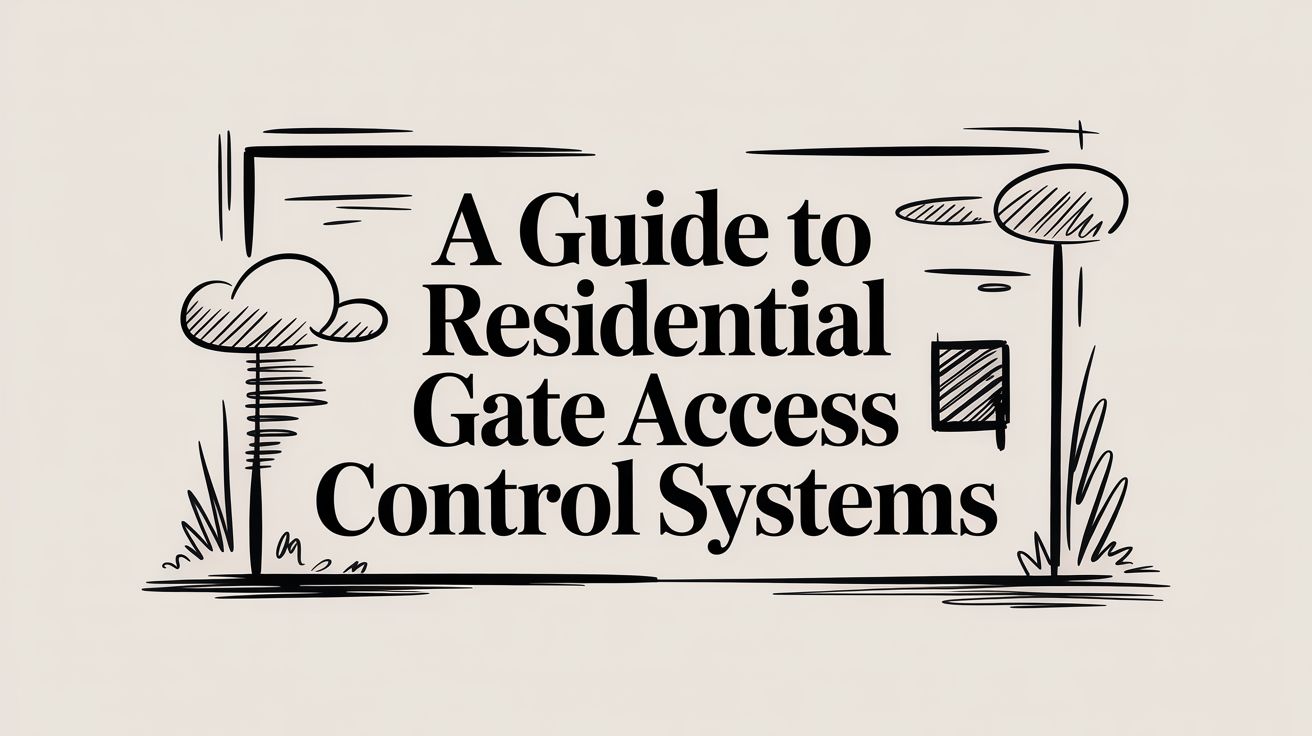
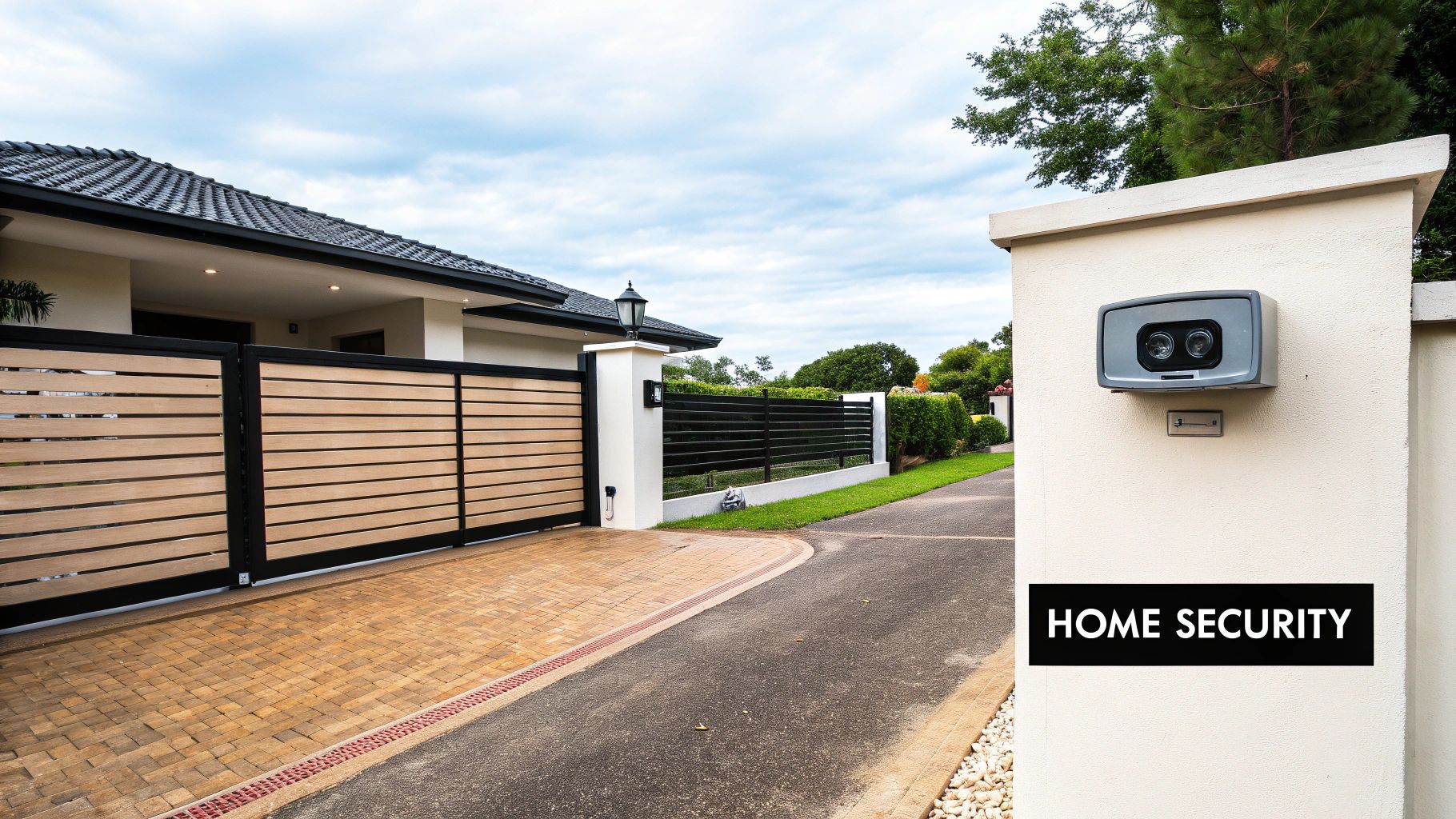
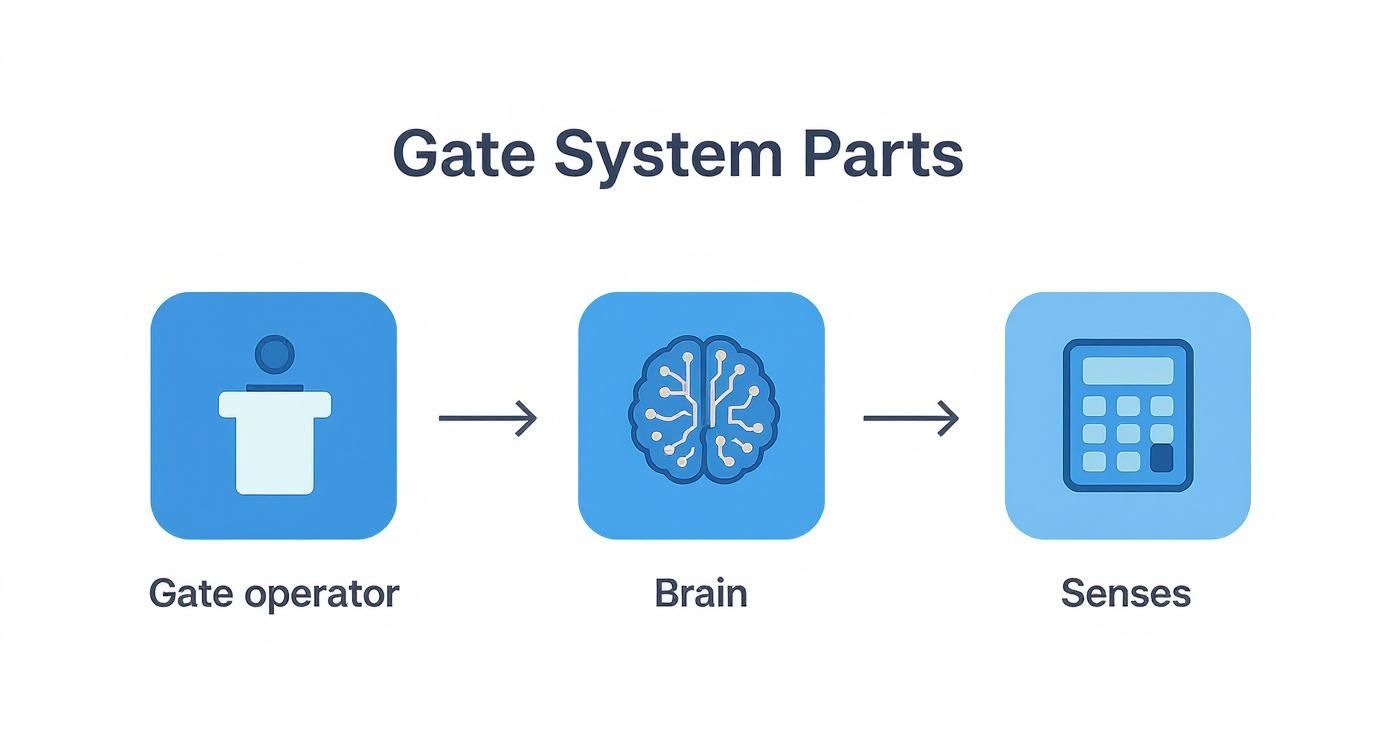
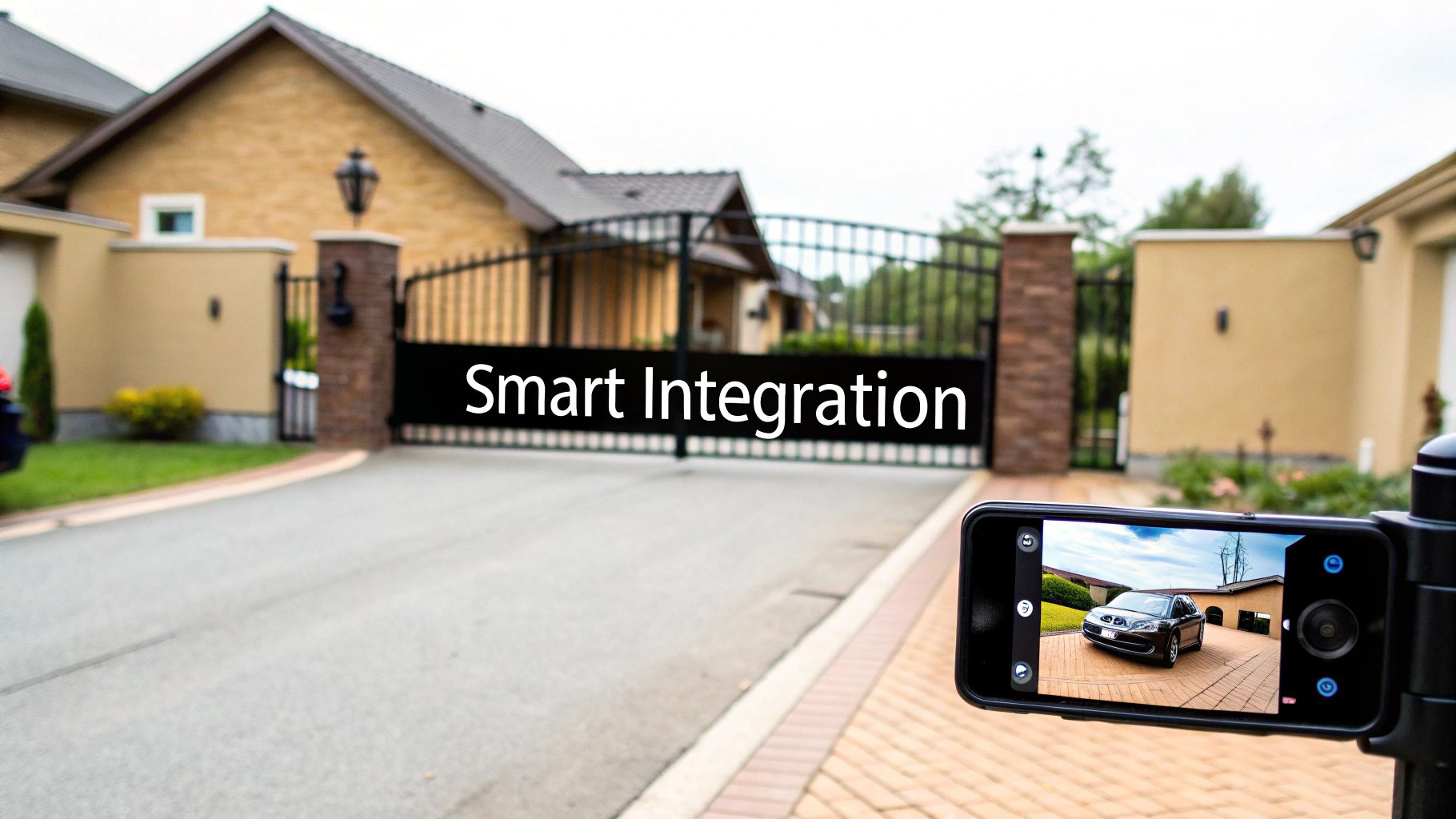

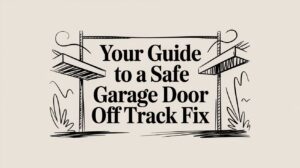


 (480) 548-0807
(480) 548-0807